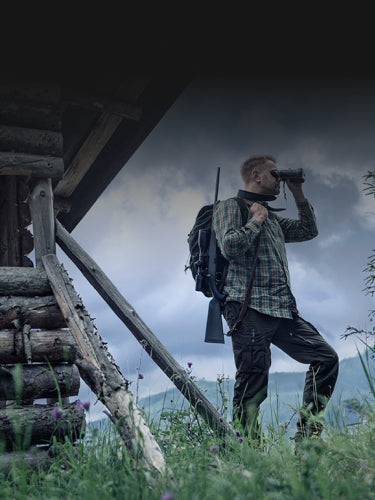The allure of coyote fur stretches back centuries, beginning with North America's storied fur trade. In the early days, coyote pelts were valued for their warmth and durability, but it wasn’t until the 20th century that they gained the broader appeal they have today. Coyote fur became especially desirable for trimming hats and coats, with its dense, warm quality proving highly effective in extreme weather. Modern hunters and conservationists alike recognize that coyote fur, particularly in winter, remains one of nature’s most efficient insulators—qualities that still drive interest in tracking and hunting coyotes today.
Detecting Coyotes with Pulsar Thermal Devices
Detecting coyotes in the field, especially during winter when they are camouflaged by thick fur, requires specialized equipment. For hunters using Pulsar’s Telos thermal monocular or the Merger thermal binoculars, picking out coyotes even in low light is a straightforward task, thanks to the devices' impressive specs. The Telos monocular offers crystal clear thermal imaging and sensitivity and can be sent back to Pulsar for additional upgrades such as a laser rangefinder (if the device does not already have one) or more refined sensors. Those who prefer binoculars can use the Merger, which provides detailed, high-definition visuals with integrated laser range-finding capabilities to measure the exact distance to reach a target. Both devices are invaluable for differentiating coyotes from domestic animals, as they reveal subtle heat differences and enhance clarity.
One of the worst things to do on a hunt is to shoot an animal one isn’t supposed to shoot at. Hunters can differentiate coyotes from similar sized dogs by their distinct, loping gait and slim build. Coyotes typically have a more sloped back, a lower-held head, and a unique, efficient gait compared to the bounding, often erratic movements of domestic dogs. When seen through the precision lenses of the Telos or Merger, these distinctive features become even more apparent, providing a clear visual signature that aids in immediate recognition.
Why Hunt Coyotes?
There are several practical reasons why coyote hunting has remained popular. Coyotes are prolific and adaptive, often coming into conflict with livestock, small pets, and even local wildlife populations. Hunting helps control their numbers and helps safeguard farms and ranches from their depredation, which is responsible for the losses of 300,000 head of livestock a year, according to the USDA’s Wildlife Services. Moreover, coyote pelts, especially those in peak winter condition, are highly valued in the fur industry for their warmth and aesthetic appeal, offering a sustainable product for those who value natural materials.
Blue vs. Prime Winter Pelts
In terms of pelt quality, hunters distinguish between blue and prime winter pelts. The term "blue" pelt dates back to early trappers who described these early-season pelts as "blue" due to the bluish hue of the underfur. They’re thinner and not fully developed, meaning the coyote’s body heat is seen more clearly on a thermal device, as the fur lacks the full insulating layer of prime pelts.
Prime winter pelts, however, are fully developed by midwinter and are prized for their thick, dense fur that acts as a superb insulator. The term “prime” is both a nod to the pelt’s quality and the coyote’s natural adaptation to peak winter conditions. These pelts have a richer color and plushness, which is highly sought after in the fur market. Physically, prime pelts have a more substantial undercoat that reflects the animal’s health and readiness for the coldest weather.
Recently, a video surfaced in which a woman mistook a thick-coated coyote for a wolf, a common misconception during the winter months.
A prime winter pelt gives the coyote a larger, more imposing appearance, sometimes blurring the line between these two species. This video serves as a reminder that, in the wild, the coyote’s winter coat can be deceiving, creating a need for high-quality optics like the Pulsar Telos or Merger to accurately assess and identify animals in the field. For the experienced hunter, recognizing these differences ensures a humane and well-informed approach to coyote hunting.
To shop Pulsar Telos monoculars, click here.
To shop Pulsar Merger binoculars, click here.
The Coyote and its Pelt
Why is coyote fur desirable?
Coyote fur is valued for its warmth and durability, making it ideal for trimming hats and coats.
How can thermal devices help in detecting coyotes?
Thermal devices like Pulsar's Telos monocular and Merger binoculars provide clear imaging and help differentiate coyotes from other animals.
What are the benefits of hunting coyotes?
Hunting coyotes helps control their numbers, protect livestock, and provides valuable pelts for the fur industry.
What is the difference between blue and prime winter pelts?
Hunters distinguish between blue and prime winter pelts based on the quality and condition of the fur.
How can hunters differentiate coyotes from domestic dogs?
Coyotes have distinct features like a sloped back and unique gait, which can be further observed through thermal devices like the Telos and Merger.




